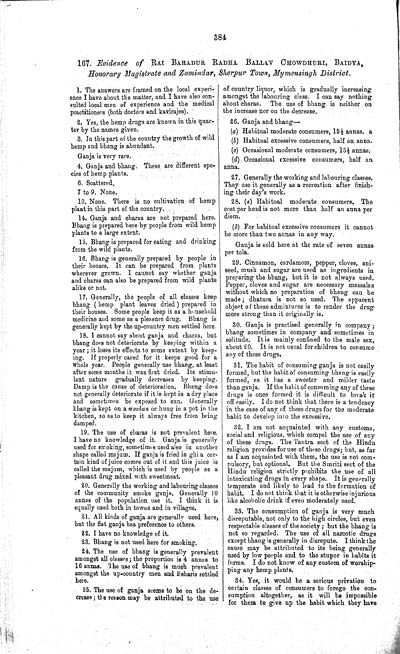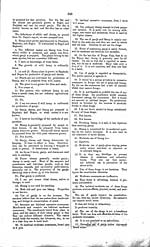Medicine - Drugs > Report of the Indian Hemp Drugs Commission, 1894-1895 > Volume IV
(398) Volume 4, Page 384
Thumbnail gallery: Grid view | List view

384
167. Evidence of
RAI BAHADUR RADHA BALLAV CHOWDHURI, BAIDYA,
Honorary Magistrate and Zamindar, Sherpur Town,
Mymensingh District.
1. The answers are
framed on the local experi-
ence I have about the matter, and I have also con-
sulted local men of experience and the medical
practitioners (both doctors and kavirajes).
2. Yes, the hemp
drugs are known in this quar-
ter by the names given.
3. In this part of
the country the growth of wild
hemp and bhang is abundant.
Ganja is very rare.
4. Ganja and bhang.
These are different spe-
cies of hemp plants.
6. Scattered.
7 to 9. None.
10. None. There is no cultivation of
hemp
plant in this part of the country.
14. Ganja and charas are not
prepared here.
Bhang is prepared here by people from wild hemp
plants to a large extent.
15. Bhang is prepared for eating
and drinking
from the wild plants.
16. Bhang is generally prepared
by people in
their houses. It can be prepared from plants
wherever grown. I cannot say whether ganja
and charas can also be prepared from wild plants
alike or not.
17. Generally, the people of all
classes keep
bhang (hemp plant leaves dried) prepared in
their houses. Some people keep it as a household
medicine and some as a pleasure drug. Bhang is
generally kept by the up-country men settled
here.
18. I cannot say about ganja and
charas, but
bhang does not deteriorate by keeping within a
year; it loses its effects to some extent by keep-
ing. If properly cared for it keeps good for a
whole year. People generally use bhang, at least
after some months it was first dried. Its stimu-
lant nature gradually decreases by keeping.
Damp is the cause of deterioration. Bhang does
not generally deteriorate if it is kept in a dry place
and sometimes be exposed to sun. Generally
bhang is kept on a machan or hung in a pot in the
kitchen, so as to keep it always free from being
damped.
19. The use of charas is not
prevalent here.
I have no knowledge of it. Ganja is generally
used for smoking, sometimes used also in another
shape called majum. If ganja is fried in ghi a cer-
tain kind of juice comes out of it and this juice is
called the majum, which is used by people as a
pleasant drug mixed with sweetmeat.
20. Generally the working and
labouring classes
of the community smoke ganja. Generally 10
annas of the population use it. I think it is
equally used both in towns and in villages.
21. All kinds of ganja are
generally used here,
but the flat ganja has preference to others.
22. I have no knowledge of it.
23. Bhang is not used here for smoking.
24. The use of bhang is generally
prevalent
amongst all classes; the proportion is 4 annas to
16 annas. The use of bhang is much prevalent
amongst the up-country men and Beharis settled
here.
25. The use of ganja seems to be
on the de-
crease; the reason may be attributed to the use
of country liquor, which is gradually
increasing
amongst the labouring class. I can say nothing
about charas. The use of bhang is neither on
the increase nor on the decrease.
26. Ganja and bhang—
(a) Habitual moderate consumers, 15½ annas. a
(b) Habitual excessive consumers, half an anna.
(c) Occasional moderate consumers, 15½ annas.
(d) Occasional
excessive consumers, half an
anna.
27. Generally the working and labouring
classes.
They use it generally as a recreation after finish-
ing their day's work.
28. (a) Habitual
moderate consumers. The
cost per head is not more than half an anna per
diem.
(b) For habitual excessive
consumers it cannot
be more than two annas in any way.
Ganja is sold here at the rate of seven
annas
per tola.
29. Cinnamon, cardamom, pepper,
cloves, ani-
seed, musk and sugar are used as ingredients in
preparing the bhang, but it is not always used.
Pepper, cloves and sugar are necessary massalas
without which no preparation of bhang can be
made; dhatura is not so used. The apparent
object of these admixtures is to render the drug
more strong than it originally is.
30. Ganja is practised
generally in company;
bhang sometimes in company and sometimes in
solitude. It is mainly confined to the male sex,
about 20. It is not usual for children to consume
any of these drugs.
31. The habit of consuming ganja
is not easily
formed, but the habit of consuming bhang is easily
formed, as it has a sweeter and milder taste
than ganja. If the habit of consuming any of these
drugs is once formed it is difficult to break it
off easily. I do not think that there is a tendency
in the case of any of these drugs for the moderate
habit to develop into the excessive.
32. I am not acquainted with any
customs,
social and religious, which compel the use of any
of these drugs. The Tantra sect of the Hindu
religion provides for use of these drugs; but, as far
as I am acquainted with them, the use is not com-
pulsory, but optional. But the Smriti sect of the
Hindu religion strictly prohibits the use of all
intoxicating drugs in every shape. It is generally
temperate and likely to lead to the formation of
habit. I do not think that it is otherwise injurious
like alcoholic drink if even moderately used.
33. The consumption of ganja is
very much
disreputable, not only to the high circles, but even
respectable classes of the society; but the bhang is
not so regarded. The use of all narcotic drugs
except bhang is generally in disrepute. I think the
cause may be attributed to its being generally
used by low people and to the stupor in habits it
forms. I do not know of any custom of worship-
ping any hemp plants.
34. Yes, it would be a serious
privation to
certain classes of consumers to forego the con-
sumption altogether, as it will be impossible
for them to give up the habit which they have
Set display mode to: Large image | Zoom image | Transcription
Images and transcriptions on this page, including medium image downloads, may be used under the Creative Commons Attribution 4.0 International Licence unless otherwise stated. ![]()
| India Papers > Medicine - Drugs > Report of the Indian Hemp Drugs Commission, 1894-1895 > Volume IV > (398) Volume 4, Page 384 |
|---|
| Permanent URL | https://digital.nls.uk/74553046 |
|---|---|
| Description | Evidence of Bengal witnesses. |
| Description | Volume 4: Evidence of witnesses from Bengal and Assam. |
|---|---|
| Attribution and copyright: |
|




